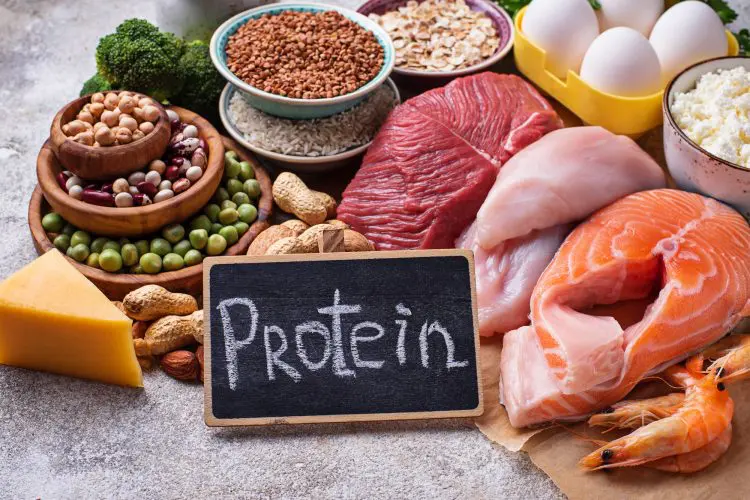Many people appear slim but, when they take off their shirts, they reveal a prominent belly and flabby arms and legs. This condition is often referred to as being “skinny fat”. Individuals who are skinny fat can seem fit from afar but, up close, they lack muscle mass and definition.
Someone who is skinny fat is likely not very strong, though they may have good cardiovascular fitness from frequent cardio exercises, but they probably don’t engage in much, if any, strength training.
Skinny fat individuals might have a normal weight for their height, showing a “normal” body mass index (BMI). However, their body fat percentage is typically high.
In this article, we explore the causes of skinny fat and provide an eight-step action plan to address this issue.
What is Skinny Fat?
People who are skinny fat often appear slender but carry excess body fat due to a lack of muscle mass.

Muscle mass is very dense, and if you have too little, you can be slender AND carry too much body fat at the same time. This means your weight may be perfectly normal, even though much of that weight is made up of fat.
Level Up Your Fitness: Join our 💪 strong community in Fitness Volt Newsletter. Get daily inspiration, expert-backed workouts, nutrition tips, the latest in strength sports, and the support you need to reach your goals. Subscribe for free!
Many skinny fat people find this concept hard to grasp as we’re often told that our body weight is an important indicator of health. That’s why a lot of exercisers diet hard and do a lot of cardio to lose weight, but still end up being skinny fat.
However, just because the scales tell you that everything is alright doesn’t mean it is. In many cases, the mirror is a much more helpful tool.
Skinny fat people often accumulate fat around their stomachs and have very prominent bellies. In fact, some thin but fat people have very little fat on their arms and legs; it’s all concentrated around their midsection. If you have no problem squeezing your legs into skinny jeans but can’t do up the waist button, there is a good chance you are skinny fat.
What Causes Skinny Fat?

Being skinny fat is caused by several factors. Identifying these causes makes the problem easier to solve. Key causes include:
Overconsumption of calories – Eating more calories than your body can use leads to fat storage. Excess calories are converted into fat and stored for later use.
For instance, if you need 2,000 calories per day but consume 2,200, you have an excess of 200 calories daily. Over a week, this could create a 1,400-calorie surplus, leading to fat gain.
Factors like genetics, gender, activity levels, and age influence where this fat is stored, often around the midsection.
Fat stored around your belly is linked to a range of health issues, including (1):
- Heart disease
- Hypertension
- Type II diabetes
- Cancer
- Hormonal imbalances
- Premature death
Sedentary lifestyle – Lack of movement contributes to a calorie surplus. Physical activity not only burns calories but also influences where those calories are stored, a process known as nutrient partitioning.
Active individuals are more likely to direct calories to their muscles and liver, while sedentary ones store them in body fat.
Modern lifestyles have become increasingly sedentary. Desk jobs, mechanized transport, and passive entertainment make it easy to avoid physical activity.
Even those who exercise regularly might be at risk. With 168 hours in a week, exercising for only 4-6 hours accounts for just 3.5% of that time.
By being more active throughout the day, you can influence nutrient partitioning to favor muscle over fat storage.
Excessive cardio – While cardio helps burn fat and create a calorie deficit, too much can reduce muscle mass. Losing both fat and muscle keeps your body composition largely unchanged, despite weight loss.
Cardio is beneficial in moderation. Overdoing it can be counterproductive, especially for those with skinny fat tendencies.
Severe calorie restriction – Drastically cutting calories leads to loss of both muscle and fat. While scale weight decreases, the ratio of muscle to fat remains similar.
Fad diets often cut calories too aggressively, resulting in muscle loss and, ultimately, a skinny fat appearance.
The result? Skinny fat!
Because of this, most skinny fat people should avoid very restrictive diets. Instead, a more sustainable, less aggressive nutritional approach works best.
Not eating enough protein – a protein deficiency means your body won’t have the building blocks it needs for muscle repair and growth. Without adequate protein, your body will start to lose muscle because it doesn’t have the raw materials necessary for muscle preservation. As muscle levels decline, body fat levels increase.

Losing muscle can also reduce your basal metabolic rate, or BMR for short, which is the number of calories you need per day. Muscle is metabolically active tissue, which means it uses energy. Losing muscle means your body needs fewer calories, and if you don’t eat less, this will create a more significant calorie surplus.
Eating too much sugar and refined carbs – sugar and refined carbs give you energy, and they can taste good too. However, when you eat them, your body has to produce a large amount of insulin. In simple terms, insulin effectively removes the resulting glucose from your blood and drives it into your cells.
Unfortunately, insulin also blocks fat burning, and any glucose that is surplus to your needs is shunted into your fat cells instead. People who have a high percentage of body fat are also more likely to be “insulin resistant,” which means glucose is more easily converted into fat.
Sugar and refined carb consumption have increased significantly over the last few decades, and so too has being overweight and obese. This is not a coincidence!
How to Cure Skinny Fatness in Eight Steps
The good news is that being skinny with a fat belly is very curable. That doesn’t mean it’s easy, but with time, energy, and effort, you can go from being skinny fat to having a fit, healthy, athletic body.
However, there is no one-hit fix. Curing skinny fatness requires a holistic, long-term approach to exercise, nutrition, and lifestyle changes.
1. Build muscle with strength training
Strength training addresses the “skinny” part of being skinny fat by building muscle. Bigger muscles create a more athletic physique. You don’t need to be a bodybuilder, but you should engage in regular, challenging muscle-building exercises.
There are lots of different approaches you can use to achieve your goals, including:
Level Up Your Fitness: Join our 💪 strong community in Fitness Volt Newsletter. Get daily inspiration, expert-backed workouts, nutrition tips, the latest in strength sports, and the support you need to reach your goals. Subscribe for free!
- Circuit training
- Combo exercises
- High-Intensity Training (HIT)
- Calisthenics
- General strength training
Aim to train 3-4 times per week to increase muscle strength, size, and tone while improving nutrient partitioning.
Post-exercise, your insulin sensitivity is at its peak, so the food you eat is more likely to nourish your muscles rather than be stored as fat. This effect lasts from 16-24 hours.
2. Use (but don’t abuse) cardio
Cardio helps create the caloric deficit needed for fat loss. However, excessive cardio can lead to muscle loss. For skinny fat individuals, short, intense cardio sessions are preferable to long endurance workouts.
2-3 cardio sessions of 20-30 minutes each week are sufficient. If you feel the need to do more, consider adjusting your diet instead.
Good cardio options include:
3. Increase NEAT

NEAT (Non-Exercise Activity Thermogenesis) combats sedentarism. NEAT includes any physical activity that isn’t a workout and is crucial for long-term weight management.
Common examples of NEAT include:
- Walking
- Taking the stairs instead of the elevator
- Mowing the lawn
- Washing your car
- Raking leaves
- Shoveling snow
- Playing with your kids
- Cycling for transport
- Taking out the trash
- Carrying groceries
- Cleaning
- Breaking up long periods of sitting with push-ups and squats
The simplest way to track NEAT is by walking. Aim for 10,000 steps per day using a pedometer app. This is roughly equal to five miles, which can be spread throughout the day.
For example, you could:
- Walk 15 minutes before breakfast
- Walk 30 minutes at lunchtime
- Walk 15 minutes after dinner
- Park a few minutes from your destination and walk the rest
- Leave your car at home for short journeys
NEAT is easy to integrate into your day, won’t cause muscle breakdown, and helps burn more calories and reduce fat.
4. Eat more protein

If you are skinny with a belly, increasing your protein intake can help. Protein preserves existing muscle mass, aids muscle growth, curbs hunger, and boosts metabolic rate.
Recommendations vary, but typically 0.8 – 1.0 grams of protein per pound of bodyweight is suggested. Protein should make up about 30-40% of your daily caloric intake.
Use this calculator to determine your precise protein needs.
5. Incorporate exercise snacks
Exercise snacks are short, frequent workouts added to your regular routine. Set a timer to go off every 60-90 minutes and do a quick set of bodyweight exercises like push-ups, lunges, or squats.
This helps:
- Increase daily caloric expenditure
- Improve posture by breaking up long periods of sitting
- Maintain insulin sensitivity
- Counteract sedentarism effects
If possible, grab an exercise snack before eating. That way, when you chow down, at least some of the food you eat will be preferentially directed toward your muscles and not your adipose tissue.
Short bursts of exercise before eating have been shown to increase levels of GLUT4, which is an insulin-regulated glucose transporter responsible for glucose uptake into muscle cells (5). If you can’t do any exercise, try isometrically contracting your major muscles prior to eating. This will also increase GLUT4 levels.
6. Create a small, sustainable caloric deficit
Alongside strength training, cardio, and NEAT, reducing food intake to create a small caloric deficit helps burn fat.
Avoid large deficits to prevent muscle loss, low energy, and hunger. Use a TDEE calculator to determine your maintenance calories, then eat 250-500 calories below that.
Focus on lean protein, healthy fats, fibrous veggies, and whole grains. A food tracking app can simplify this process.
7. Engage in targeted core training
While doing abs exercises won’t make the fat melt from your midsection, strengthening the underlying muscles will lead to a flatter, firmer stomach so that, as you lose fat, your abdomen looks and feels a whole lot better.
Treat your abs like any other muscle by overloading and challenging them with strength training exercises.
Effective core exercises include:
Do sets of 8-20 reps. If you can do more than 20 reps, increase resistance or progress to a more challenging exercise.
8. Prioritize sleep
Sleep is crucial for muscle recovery and overall health. Insufficient sleep undermines muscle growth, increases insulin resistance, hunger, and low energy.
Adults need 7-9 hours of sleep per night. Lack of sleep is linked to weight gain, while adequate sleep promotes faster fat loss.
Improve sleep by going to bed earlier, maintaining a consistent sleep schedule, and removing distractions from the bedroom.
Learn more about the importance of adequate sleep here.
Wrapping Up
To look good both in and out of clothes, avoiding the skinny fat condition is essential. Excessive cardio and extreme diets might reduce weight but can still leave you with a fat abdomen. A holistic approach including exercise, nutrition, and lifestyle changes is necessary to cure skinny fatness.
Implement the strategies in this article to build muscle, burn fat, and achieve a healthy, athletic body. Say NO to being skinny fat!
References:
- Emery EM, Schmid TL, Kahn HS, Filozof PP. A review of the association between abdominal fat distribution, health outcome measures, and modifiable risk factors. Am J Health Promot. 1993 May-Jun;7(5):342-53. doi: 10.4278/0890-1171-7.5.342. PMID: 10148711. https://pubmed.ncbi.nlm.nih.gov/10148711/
- Durrant ML, Garrow JS, Royston P, Stalley SF, Sunkin S, Warwick PM. Factors influencing the composition of the weight lost by obese patients on a reducing diet. Br J Nutr. 1980 Nov;44(3):275-85. doi: 10.1079/bjn19800042. PMID: 7437413. https://pubmed.ncbi.nlm.nih.gov/7437413/
- Borghouts LB, Keizer HA. Exercise and insulin sensitivity: a review. Int J Sports Med. 2000 Jan;21(1):1-12. doi: 10.1055/s-2000-8847. PMID: 10683091. https://pubmed.ncbi.nlm.nih.gov/10683091/
- Levine JA. Non-exercise activity thermogenesis (NEAT). Best Pract Res Clin Endocrinol Metab. 2002 Dec;16(4):679-702. doi: 10.1053/beem.2002.0227. PMID: 12468415. https://pubmed.ncbi.nlm.nih.gov/12468415/
- Richter EA, Hargreaves M. Exercise, GLUT4, and skeletal muscle glucose uptake. Physiol Rev. 2013 Jul;93(3):993-1017. doi: 10.1152/physrev.00038.2012. PMID: 23899560. https://pubmed.ncbi.nlm.nih.gov/23899560/
- Jåbekk P, Jensen RM, Sandell MB, Haugen E, Katralen LM, Bjorvatn B. A randomized controlled pilot trial of sleep health education on body composition changes following 10 weeks’ resistance exercise. J Sports Med Phys Fitness. 2020 May;60(5):743-748. doi: 10.23736/S0022-4707.20.10136-1. Epub 2020 Mar 4. PMID: 32141273. https://pubmed.ncbi.nlm.nih.gov/32141273/















